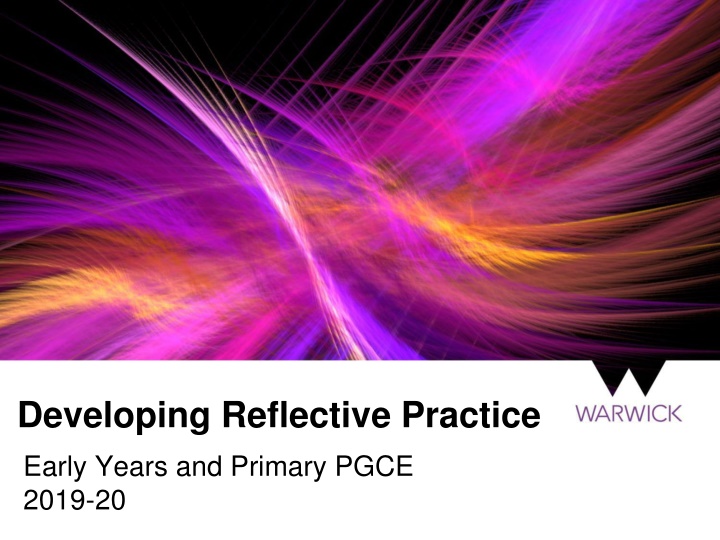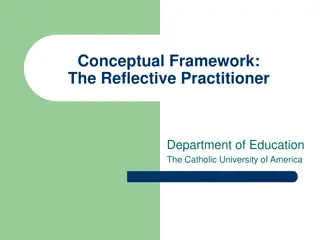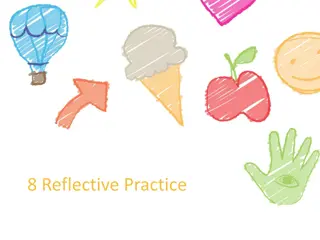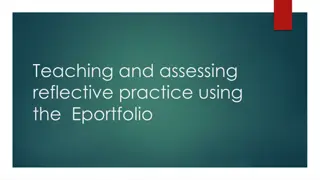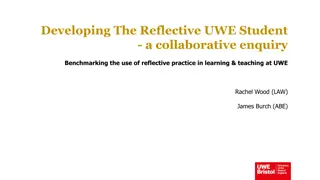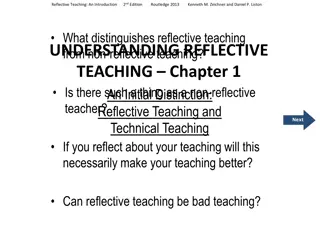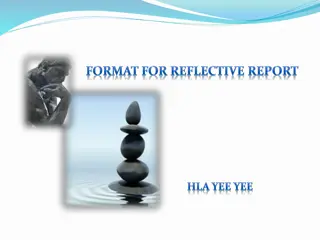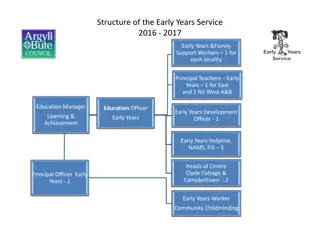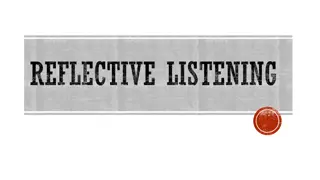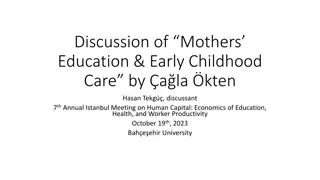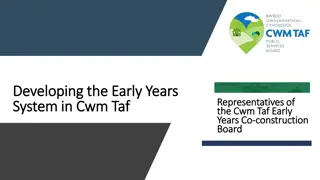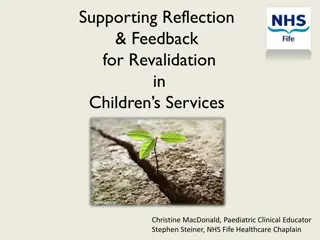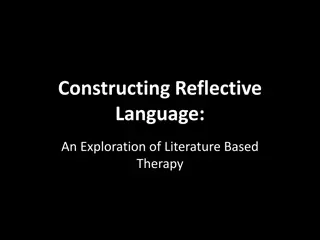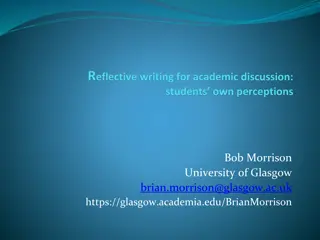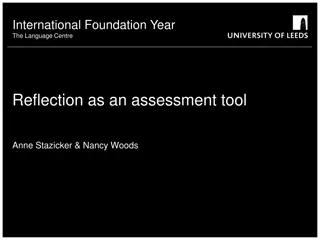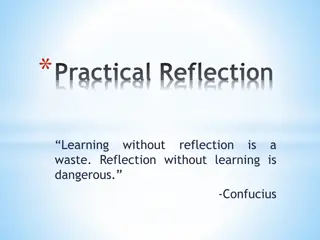Developing Reflective Practice in Early Years & Primary Education
Reflect on the importance of reflective practice in teacher training programs like PGCE, focusing on personal reflection, professionalism, and improvement in teaching approaches. Explore definitions, learning cycles, and theories to enhance understanding and application of reflective practice in educational settings.
Download Presentation

Please find below an Image/Link to download the presentation.
The content on the website is provided AS IS for your information and personal use only. It may not be sold, licensed, or shared on other websites without obtaining consent from the author.If you encounter any issues during the download, it is possible that the publisher has removed the file from their server.
You are allowed to download the files provided on this website for personal or commercial use, subject to the condition that they are used lawfully. All files are the property of their respective owners.
The content on the website is provided AS IS for your information and personal use only. It may not be sold, licensed, or shared on other websites without obtaining consent from the author.
E N D
Presentation Transcript
Developing Reflective Practice Early Years and Primary PGCE 2019-20
Practical Reflection Tuesday s self-study task: Choose an image or object that represents how you feel at this point in time; bring this to the seminar In small groups share your choice, reasons for your choice and your reflections
The year ahead Reflecting upon the PGCE year ahead, anonymously share your: hopes fears
Objectives To: promote personal reflection; develop your understanding of reflective practice and its centrality to professionalism; understand the purpose of reflective practice and its importance to ITE trainees;
Teachers Standards TS 4: reflect systematically on the effectiveness of lessons and approaches to teaching TS 8: take responsibility for improving teaching through appropriate professional development, responding to advice and feedback from colleagues
Definitions of reflection, reflective practice, reflexivity In groups of 3 (one A, B and C) briefly share your definitions. Aim: identify the key similarities and differences between them 15 mins (max)
A. Kolbs Learning Cycle http://www2.le.ac.uk/departments/gradscho ol/training/eresources/teaching/theories/kol b
B. Reflection according to Bolton (2006) Reflection is an in-depth consideration of events or situations: the people involved, what they experienced, and how they felt about it. This involves reviewing or re-living the experience to bring it into focus, and replying from diverse points of view. Seemingly innocent details might prove to be key; seemingly vital details may be irrelevant (Bolton, 2010, p. xvix) Reflection is a state of mind, an ongoing constituent of practice, not a technique, or curriculum element. Reflective Practice can enable practitioners to learn from experience about themselves, their work, and the way they relate to home and work, significant others and wider society and culture. It gives strategies to bring things out into the open, and frame appropriate and searching questions never asked before. It can provide relatively safe and confidential ways to explore and express experiences otherwise difficult to communicate. It challenges assumptions, ideological illusions, damaging social and cultural biases, inequalities, and questions personal behaviours which perhaps silence the voices of others or otherwise marginalise them. (Bolton, 2006, pp.3)
C. Reflection according to Schon (1991) When we reflect, we consider deeply something which we might not otherwise have given much thought to. This helps us to learn. Reflection is concerned with consciously looking at and thinking about our experiences, actions, feelings and responses and then interpreting or analysing them in order to learn from them (Boud et al., 1994; Atkins and Murphy, 1994). Typically we do this by asking ourselves questions about what we did, how we did it and what we learnt from doing it. Sch n (1991) distinguishes between reflection-on-action and reflection-in- action in the following way: Reflection-in-action is concerned with practising critically. So, a physiotherapy student working with a client on an exercise programme is making decisions about the suitability of particular exercises, which exercise to do next and judging the success of each exercise at the same time as they are conducting the activity. Reflection-on-action on the other hand, occurs after the activity has taken place when you are thinking about what you (and others) did, judging how successful you were and whether any changes to what you did could have resulted in different outcomes. http://www.learningdevelopment.plymouth.ac.uk/LDstudyguides/pdf/11R eflection.pdf
Reflexivity: What is it? Reflexivity is concerned with reflection upon the self within teaching (Warin et al., 2006, p.242) Ashmore (1989) outlines the many uses and meanings of 'reflexive'. Included in these are reflexivity as self-reference, as self-awareness. Many writers take the meaning from its Latin derived dictionary definition: to turn back on oneself (Bourdieu & Wacquant, 1992; Lawson, 1985; Steier, 1991). This is interpreted to mean that people have to think about their own concepts and what they bring to any situation. (Matthews and Jessel, 1998) In contrast to the view that people can be objective, reflexivity argues that we have a social and intellectual unconscious and consciousness that we bring to any situation. .to find a way of standing outside the self .it enables becoming aware of the limits of our own knowledge of how our own behaviour is complicit in forming organisational practices which for example, marginalise groups or exclude individuals. Reflexivity uses strategies such as internal dialogue to make aspects of the self strange. It requires being able to stay with personal uncertainty, critically informed curiosity and flexibility to find ways of changing deeply held ways of being: a complex, highly responsible social and political activity. (Bolton, 2010, p. xvix)
Reflection or Reflexivity? I just do not get on with my classes. They do not respect me and I cannot seem to establish my authority. The school-based tutor has suggested that I sit and work with a group of pupils during some lessons and talk to them to see how they are feeling.... When I worked with the pupils I realised how boring they found much of the work, and that they did not respect teachers who were not interested in them. I realised that they did respect, and responded to, some of the teachers, but that the teacher has to earn respect. I have begun to realise that I had been brought up to believe that the young should automatically respect their elders, and that pupils should therefore obey teachers. It is painful for me to realise that this is not the case, and that I will have to earn their respect. Even more, through talking to the pupils, I realise that I have to respect them and that this is part of the process. I thought I did, and still think I do, but perhaps I am just not communicating it to them. I think that these are the areas I am going to have to work on to improve my discipline. (Matthews and Jessel, 1998, p. 233-234)
Purposes of Reflective Practice (Theory to Practice)
Scheduled Reflection in the PGCE Programme Reflection on lessons you have taught (lesson evaluation proforma) and Reflective discussions in school with class teachers, Mentors and University Moderation tutors in school Reflection on your progress at specific points, recorded in your e-PDP Group Reflection sessions after each placement
Levels of reflection 1. Descriptive writing: writing that is not considered to show evidence of reflection: it is a description with no discussion beyond description. 2. Descriptive reflection: There is a description of events. The possibility of alternative viewpoints is accepted but most reflection is from one perspective. 3. Dialogic reflection: the work demonstrates a stepping back from events and actions leading to a different level of mulling about discourse with self and exploring the discourse of events and actions . There is a recognition that different qualities of judgement and alternative explanations may exist for the same material. The reflection is analytical or integrative, though may reveal inconsistency. 4. Critical reflection: Demonstrates an awareness that actions and events are not only located within and explicable by multiple perspectives, but are located in and influenced by multiple historical and socio-political contexts Moon (2006) p.40-41
Example 1 Sam had been receiving support from a TA during PE to help him keep calm and make the right behavioural choices. However feedback from the PE teacher said that this support had not lead to a noticeable improvement in his behaviour. Although Sam can be very disruptive in whole class situations his behaviour in PE is far worse and occasionally dangerous. I critically reflected on my current assumptions, PE and Sam s behaviour during it. I realised that there are huge differences between PE and a normal classroom based lesson - teacher, location, clothes, activity, rules, equipment - and that he might not automatically transfer the expectations of his behaviour in the classroom to this lesson, as other children would. Cole writes that a crucial factor in effective provision for children with SEBD (Social, Emotional and Behavioural Difficulties) is building pupils self-esteem through successful achievement (Cole in Hunter-Carsch, 2006, 245). The school hall is a place where Sam has repeatedly failed and often been publically shamed, during assemblies, PE and after school clubs; he is therefore likely to find the hall an intimidating and scary place to go to, which is a likely cause of his more extreme behaviour. In the classroom Sam has a safe place, his desk, where he can go when asked, or of his own accord, to calm down during lessons. This means that he does not fail as often during class as his behaviour does not escalate to a point where he gets sent out. With this in mind I created a safe place in the school hall. I began by sitting down with Sam and chatting about all the reasons why he enjoys PE, he then drew pictures of these reasons on special card. We then discussed how he could ensure that he stayed in PE; on another card he wrote the message KEEP CALM in huge letters. After laminating, we went to the school hall and spent some time picking out a corner of the hall where we could hang his picture. We then spoke to the PE teacher, Sam explained that if the teacher felt like Sam needed to calm down during lessons then the teacher needed to give Sam his Calm Card and he would sit in the special corner of the hall where his picture was hung. So far this strategy has been very effective and Sam successfully stayed in PE every lesson that he attended this term. Sam s behaviour often escalates due to verbal confrontation and I believe this strategy has been particularly effective as it is completely non-verbal.
Example 2 Year 6: Read Write Inc has just been introduced to the school, it is used for both phonics (20 minutes each morning) but also for literacy lessons (up to year 3). Children are showing good progress in both reading and writing since the scheme was introduced. I was able to shadow the 'Phonics leader' while she assessed children in Ks1. Read Write Inc has also just been introduced to the school I will be working at in September, and although I will be teaching year 5, all staff will be given the opportunity to attend an introductory Read Write Inc session.
Example 3 Behaviour management was something that I was worried about since I am not a particularly assertive person and tend not to shout. However, the seminar on Behaviour to Learn really helped with methods of managing behaviour and most importantly, preventing difficulties in the first place. I found the 10 principles of effective behaviour management and Charlie Taylor's Behaviour checklist (Dfe, 2011) really useful and plan to use these for my placements to put theory into practice. Reading 'Behaviour for Learning' (Ellis and Tod, 2009) has helped me to begin to understand the distinction between behaviour management for the sake of safety and keeping order, and behaviour management which is focused on promoting learning. On PP1 and Serial Placement, I saw how behaviour to learn theories were implemented in the classroom. I am not yet at a point where I am able to fully use my developing knowledge of behaviour management strategies because I have largely been in an observing role. However, in small groups I have begun to use praise and motivational strategies to promote good behaviour which has improved my confidence.
We learn not from doing, but by thinking about what we do. Anon.
Plenary To: Reflect upon your feelings at this point in your course; develop your understanding of reflective practice and its centrality to professionalism; understand the purpose of reflective practice and its importance to ITE trainees;
References Bolton, G. (2010) Reflective Practice (third edition) London: Sage Leicester University: Kolb s Experiential Learning Cycle available online at: http://www2.le.ac.uk/departments/gradschool/training/eresources/teaching/t heories/kolb Accessed 24.7.17 Matthews, B. & Jessel, J. (1998) Reflective and Reflexive Practice in Initial Teacher Education: a critical case study Teaching in Higher Education, 3:2, 231-243 Moon, J. Learning Journals A handbook for Reflective Practice and Professional Development (second edition) London: Routledge Pollard, A. (2005) Reflective Teaching (third edition) London: Continuum Schon, D. (1991) cited in Plymouth University available online at: http://www.learningdevelopment.plymouth.ac.uk/LDstudyguides/pdf/11Refle ction.pdf accessed 24.7.13 Warin, J., Maddock, M., Pell, A. and Hargreaves, (2006) L. Resolving identity dissonance through reflective and reflexive practice in teaching Reflective Practice 7: 2 pp. 233 245
